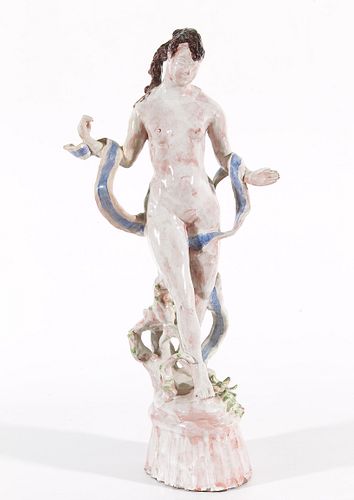DINA KUHN (Vienna 1891 - 1963 Brachttal-Schlierbach) Lenz
Estimate:
EUR€1,200 - EUR€2,400
$1,304.35 - $2,608.70
Absentee vs Live bid
Two ways to bid:
- Leave a max absentee bid and the platform will bid on your behalf up to your maximum bid during the live auction.
- Bid live during the auction and your bids will be submitted real-time to the auctioneer.
Bid Increments
| Price | Bid Increment |
|---|---|
| EUR€0 | EUR€10 |
| EUR€100 | EUR€50 |
| EUR€700 | EUR€100 |
| EUR€1,000 | EUR€200 |
| EUR€3,000 | EUR€300 |
| EUR€3,600 | EUR€400 |
| EUR€4,000 | EUR€500 |
| EUR€7,000 | EUR€1,000 |
| EUR€16,000 | EUR€2,000 |
| EUR€30,000 | EUR€3,000 |
| EUR€36,000 | EUR€4,000 |
| EUR€40,000 | EUR€5,000 |
About Auction
By Widder Auctions
May 19, 2022
Set Reminder
2022-05-19 11:00:00
2022-05-19 11:00:00
America/New_York
Bidsquare
Bidsquare : Masterpieces
https://www.bidsquare.com/auctions/widder-auctions/masterpieces-9287
Masterpieces of classical modernism by Austrian and international artists coming up for auction in Vienna on May 19th Widder Auctions office@widderauktionen.com
Masterpieces of classical modernism by Austrian and international artists coming up for auction in Vienna on May 19th Widder Auctions office@widderauktionen.com
- Lot Description
DINA KUHN*
(Vienna 1891 - 1963 Brachttal-Schlierbach)
Lenz
ceramic, enameled, 52 cm
monogrammed DK, Wiener Werkstätte, Faience, cream white glazed, glaze painting in blue, pink and purple-brown
inside the base inscribed: WW 375, DK (embossed)
Provenance: Fine Arts Widder
ESTIMATE € 1.200 - 2.400
Austrian ceramist and craftswoman of the 20th century. From 1912 studied at the Kunstgewerbeschule in Vienna with Josef Hoffmann, Oskar Strnad, Franz Cizek, Kolo Moser and Michael Powolny. Member of the Wiener Werkstätte, Produced designs for ceramic figures, wallpaper, fabric patterns, fireplace coverings, tiles, stoves, lamps and vases. 1923 Founded her own ceramic workshop with her brother and Emanuel Iskra. Also designed ceramics for the Friedrich Goldscheider manufactory, the Augarten porcelain manufactory and the Bimini glass manufactory in the 1920s. Worked from 1937 for the Waechtersbach ceramics manufactory in Brachttal-Schlierbach, Hesse, where she also lived from 1940. Member of the Association of Women Artists of Austria and the Vienna Women's Art.
The Wiener Werkstätte set out to create artistically high-quality handicrafts in all areas of everyday use - from furniture and architecture to porcelain, glass and fashion - in close contact between artists and consumers. It is the interdisciplinary claim to holistic permeation of all areas of life as well as their trend-setting designs with which the Wiener Werkstätte has written design history in the long term. Its founder, the architect Josef Hoffmann, joined the graphic artist and painter Koloman Moser and the patron Fritz Waerndorfer in 1903 with the aim of founding the now world-famous Wiener Werkstätte association for handicrafts. They wanted to establish a marketable aesthetic counterpoint to encrusted historicism. It is often overlooked that women also played a key role in this success story. In 1937 around 180 of the company's female artists were named. Most of these women received their education at the Vienna School of Applied Arts and were finally brought to the WW by Hoffmann to bring their creative energy to bear in the fields of textile design, fashion, home accessories, toys, art and ceramics. They also developed unusual wall designs for interiors - be it apartments, bars or exhibition rooms. With the dissolution of the Wiener Werkstätte in 1932, many of the women artists who were highly regarded at the time were largely forgotten.
PLEASE NOTE:
The purchase price consists of the highest bid plus the buyer's premium, sales tax and, if applicable, the fee of artists resale rights. In the case of normal taxation (marked ° in the catalog), a premium of 24% is added to the highest bid. The mandatory sales tax of 13% is added to the sum of the highest bid and the buyer's premium. The buyer's premium amounts to 28% in case of differential taxation. The sales tax is included in the differential taxation. - Shipping Info
-
Shipping
We will send you the invoice shortly after the auction. As soon as we have recieved the amount, the art can be picked up at Johannesgasse 9-13, 1010 Vienna. Please note that the buyer is responsible for pick-up and shipping of the lot.
Should you wish to ship your items, please contact: Mailboxes Email: oper@mbe-co.at Tel: 01 5128855
Please note that storage fees may apply, should the pieces not be picked up within 14 days after invoicing for domestic and 28 days for international transportation.
Our team will be happy to assist you with any further information at office@widderauktionen.com or at 0043 676 555 66 10.
-
- Buyer's Premium



 EUR
EUR CAD
CAD AUD
AUD GBP
GBP MXN
MXN HKD
HKD CNY
CNY MYR
MYR SEK
SEK SGD
SGD CHF
CHF THB
THB





